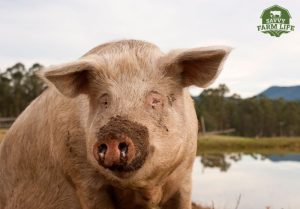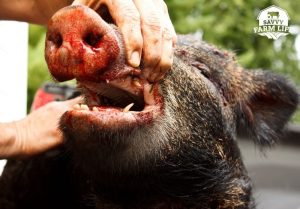
All You Need to Know About Male Pigs
Pig terminology can be confusing, as there are many terms seemingly used for the same animal. Just think about the terms pig, hog, and swine and whether there is a difference between the three (the answer depends on who you ask). Most of us know that a baby pig is called a piglet, and some of us know that a mother pig is called a sow. But what about male pigs?
What is a male pig called? Castrated male pigs are called barrows or stags, while unaltered male pigs are called boar. Most male pigs intended to be processed for meat production are castrated, due to the offputting taste and the challenging behavior that is more common among boar. Both barrows and boar will reach a higher mature weight than sows and gilts, and are known to grow more rapidly.
Are you wanting to get pigs and are wondering if you should get males? Or did your sow just produce its first litter and you’re wondering what you should do with the male piglets? To learn all you need to know about male pigs, read on!
How Big Do Male Pigs Get?
How large a pig will get depends on its breed, but on average, male pigs reach a mature weight of 100 – 150 pounds larger than females. For most domestic (farm) breeds, barrows and boar can reach a weight of 500 – 700 pounds.
Most pigs are processed for meat when they reach 250 – 300 pounds for meat quality and ease of processing so most market hogs will never reach their full weight potential. While both male and female pigs are bred to reach market weight rather quickly, male pigs will mature slightly faster than female pigs.
The largest pig on record was a male Poland China pig named Big Bill who lived in the 1930’s. He was five feet tall, nine feet wide, and weighed just over 2,500 pounds.
How big do female pigs get? To learn more, visit my article What a Female Pig is Called & Other Female Pig Facts.
Male Pig Reproductive Behavior
While most male pigs used for meat are castrated when they are young, you need boar to produce more pigs. Outside of small homesteading operations, it is usually more economical to breed piglets yourself as opposed to purchasing piglets. Unless you are using artificial insemination, you will need to keep about one boar for every twenty or so sows.
Boar can be used to determine which of your sows or gilts are in heat. If kept adjacent to the female pen, you will see gilts and sows standing near the boar pen when they are receptive to them. This will be especially true for the more mature boar – the older, the smellier – and nothing captures a female pig’s attention like a big, smelly boar. You will also see the boar showing increased interest in the females, eliciting the flehman response (pulling back the lips to get a bitter “sniff”) and grunting a “courting song”.
Once a boar is introduced to a receptive female, he will spend a few minutes displaying his interest – sniffing her around the sides and flanks, nudging her, and producing excess saliva in the mouth (excreted androstenone). If interested, the female will stand still for the boar, at which time he will mount her.
Pig reproductive behavior has been studied at length, with a few interesting results worthy of note. Boar who are raised without visual contact with female pigs (regardless of whether they can hear and/or smell them) show reduced sexual activity compared to boar raised with visual contact. Additionally, boar who engage in a longer duration of courtship activity have a greater conception rate than those who engage in a shorter courtship – the assumption is that this is due in large part to the oxytocin that the female releases.
Boar Taint and Male Pig Castration
“Boar taint” is the term used for the unappealing taste of the meat from unaltered male pigs. This taste is a result of two compounds – androstenone and skatole.
Androstenone is a testicular steroid that smells like urine. It is a pheromone that can attract the interest of sows and encourage puberty in females. Skatole is a by-product of the amino acid tryptophan, and smells like fecal matter. Unaltered males have higher levels of skatole due to the higher activity of testosterone and androstenone.
With one compound smelling like urine, and the other smelling like fecal matter, it is easy to see why most people prefer the taste of pork from female pigs and castrated males.
Boar taint is the number one reason that market hogs are castrated. Castrated pigs are also easier to handle and exhibit fewer behaviors that can become problematic in a group setting such as aggression and mounting. One downside to castrating, however, is that it lowers feed efficiency. It takes 10-15% more feed for a barrow to gain the same amount of weight as a boar.
While castrating a boar sounds intimidating, it can be fairly easy to learn and perform. Piglets can be castrated as early as one day of age, though take care if castrating this early, as it can be difficult to spot a scrotal hernia. If you castrate a piglet who has an unidentified hernia, it will need to be sutured immediately to prevent lethal consequences. For this reason, it is often preferred to perform castration when the piglet is a week old. At this age it is easier to identify scrotal hernias, and the piglets are still young enough that they will not experience as much pain as an older piglet.
At What Age Can A Male Pig Be Used For Breeding?
 With most mammals, it is important to avoid breeding a female too early. When it comes to pigs, boar are integral to the health and success of the breeding program, and it is just as important that you do not use a boar for servicing (breeding) before he is physically ready. While a boar can be used for occasional breeding as young as 6-7 months of age, he should not be used for regular use until he is older. By 8 months of age a boar can be used for servicing more regularly, between 2 and 4 times per week. At 12 months of age the boar is considered mature and can be used for 6 to 10 services per week. When breeding a boar for the first time, choose a gilt or a calm, docile sow as his partner. This will help bolster his performance and confidence.
With most mammals, it is important to avoid breeding a female too early. When it comes to pigs, boar are integral to the health and success of the breeding program, and it is just as important that you do not use a boar for servicing (breeding) before he is physically ready. While a boar can be used for occasional breeding as young as 6-7 months of age, he should not be used for regular use until he is older. By 8 months of age a boar can be used for servicing more regularly, between 2 and 4 times per week. At 12 months of age the boar is considered mature and can be used for 6 to 10 services per week. When breeding a boar for the first time, choose a gilt or a calm, docile sow as his partner. This will help bolster his performance and confidence.
It is important to select optimal boar for breeding, because the boar is important to the success of the breeding program. You will want healthy boar who have ideally been tested for performance. You will want boar who have been raised with other pigs, preferably within visual contact of gilts and sows. This early socialization and exposure can greatly influence a boar’s libido. You will also want to choose a boar with sound legs. Mating, specifically mounting, can be physically taxing for a heavy boar and you will want to avoid using boar with weak or malformed legs and/or feet.
When can a a female pig get pregnant? To know more visit my article When Can a Pig Get Pregnant? (& Other Pig Pregnancy Facts.)
Do Male Pigs Have Tusks?
Domestic boar grow tusks similar to their wild cousins. In fact, all pigs grow tusks – boar, barrows, and sows alike. You may not notice these teeth because barrows, sows, and gilts will grow these tusks more slowly than boar. Growing tusks are fueled by testosterone, and so it is the boar’s tusks that become quite noticeable. While some farmers trim their boar’s tusks, others leave them alone.
Piglets are born with several “needle teeth” that can cause injury to the sow’s teat and to the other piglets. To minimize the potential for injury, most pig farmers clip these needle teeth within hours of birth. This is a simple process that is accomplished with special teeth clippers.
Male Pigs In The Wild
Feral and wild hogs have unique and delicate social hierarchies that they abide by. Typical feral groups, or sounders, consist of two or more sows and their offspring. At around 8-15 months of age the sows will encourage the male piglets to leave the sounder, at which time the young males will form their own bachelor group. While young boar will often stick together for a time, as the males mature and grow older they will usually prefer living solitary lives and will break away from their sub-group.
Male Pigs Are Intelligent, Social Animals
Pigs in general are incredibly intelligent and social animals. It is easy to bond with a pig, and even easier when you are keeping that pig and allowing it to mature so that you can use it for breeding purposes. While boar are known to be more aggressive than barrows and sows, there are also many farmers who have a “favorite boar” – a male pig who has an exceptionally personable and docile temperament. Fortunately, with pigs being as prolific at breeding as they are, you can be choosy about which boar you will keep for breeding purposes.
Are you planning on raising pigs? What supplies do you need to have a pig farm? To learn more, visit my article What Do Pigs Need? Top Pig Supplies You Need.
